Category: General

2025 Chevrolet Blazer EV SS arrives for $61,995
The 2025 Chevrolet Blazer EV SS is due to arrive soon, with a lot more power, at a $61,995 base price including the mandatory $1,395 destination fee.
That price, which is now shown in Chevy’s online configurator, is the same as what Chevy quoted last September when it detailed the 2025 Blazer EV lineup, and about $3,500 less than when the Blazer EV SS (short for Super Sport) was initially confirmed.
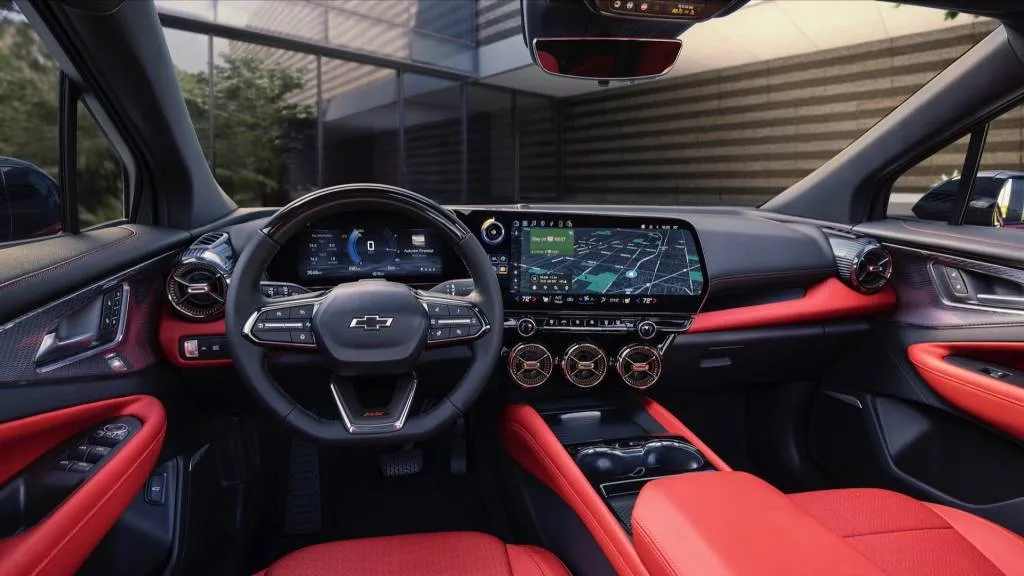
2025 Chevrolet Blazer EV SS
Pricing isn’t the only thing that’s fluctuated since this model was announced in 2022. At that time, Chevy said its dual-motor all-wheel-drive powertrain would develop 564 hp and 684 lb-ft of torque using the Wide Open Watts (WOW) performance mode. That changed to 595 hp and 645 lb-ft when Chevy reconfirmed the Super Sport in late 2023. But it’s now been finalized at 615 hp and 650 lb-ft of torque, a Chevy spokesperson confirmed to Green Car Reports.
Chevy also lists a 3.4-second 0-60 mph time that’s consistent with its previous claims of a sub-four-second time. A retuned suspension is part of the package as well, but it doesn’t appear that Chevy performance-enhancing changes are as extensive as those of the Hyundai Ioniq 5 N, which its maker claims is just as quick, and we’ve found to be truly track-capable. However, it’s also a bit pricier, at $67,475 with destination.

2025 Chevrolet Blazer EV SS
The automaker previously confirmed that the AWD SS would use the same 102-kwh battery pack as RWD RS models (all other models have an 85-kwh pack) but EPA range had not been confirmed at press time.
An initial 2024 Chevy Blazer EV test drive left us impressed with this electric SUV’s efficiency and range. Software issues led to a pause in sales in December 2023, though, and Chevy cut prices the following March, making for a rough initial model year. For 2025, certain models get a boost in both EPA range and output, while a base front-wheel-drive model arrives at the opposite end of the lineup from the range-topping SS.
—
UPDATED: An earlier version of this story listed the Blazer EV SS’ base price with destination as $62,490. The correct price is $61,995.

Future GM EVs might be able to juggle two charge ports at once
General Motors is looking at different ways to utilize electric-vehicle bidirectional charging capability and multiple charge ports, a newly surfaced patent filing shows.
Published by the United States Patent and Trademark Office (USPTO) Dec. 26, 2024, after being filing by GM Jun. 22, 2023, the document deals less with specific hardware and more with usage schemes and control strategies—and how to balance current in and out of different charge ports.
What it could lead to is a greater flexibility for charging or discharging EVs at any given time, as energy storage devices.
GM lays out a few examples of how this capability can be combined with multiple charge ports, including using one port to charge an EV while using the second port to send power to an external energy-storage system.

General Motors multi-port bidirectional charging patent image
Another possibility is “daisy-chained” vehicles, with only one vehicle actually plugged into a conventional charging station. That vehicle would then be connected to a second vehicle via its other charge port. That second vehicle could in turn be used to charge a third vehicle in a similar manner, according to GM.
This will require a new generation of charge controllers, the patent underscores, and a new range of thinking about how people will use bidirectional charging capability. A fleet of compatible vehicles would be required as well.
GM has expanded bidirectional charging across its lineup, but only with one charge port as of yet. It’s already laid out what large electric trucks might be able to do with multiple charge ports in a separate patent filing, though.
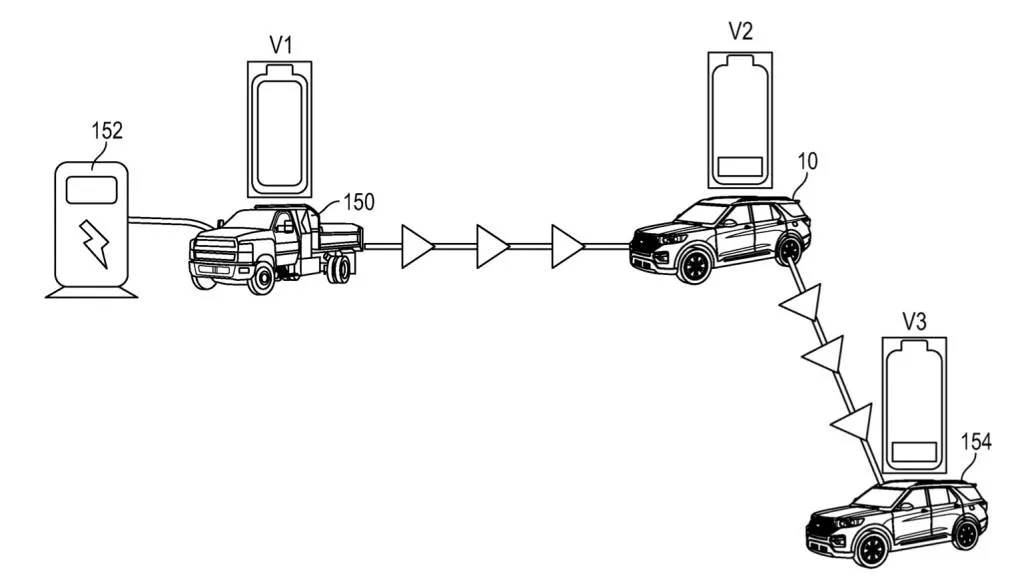
General Motors multi-port bidirectional charging patent image
Ford has also, in a patent, previously laid out what multiple charge ports might accomplish. That includes connecting multiple EVs in series, similar to what GM is discussing here.
Other automakers, such as Tesla, have also discussed adding bidirectional charging capability, while Volvo has shifted that capability into a separate energy business. But it might take mandates like the one proposed by California to further scale up bidirectional charging—and unlock some of the possibilities GM apparently sees in the tech.

Trump DOT freezes EV charger funding, demands new state plans
- DOT to review $7.5B federal EV charging program, funded with 2021 Bipartisan Infrastructure Law
- Keeps funding projects in progress but rescinds guidance for continued buildout
- Means new state proposals for rules not yet released, months of delay for states’ funding
- Tesla has captured more than $41 million in government money for the buildout
The Trump Administration is stalling on dispersing more funds to U.S. states for the Biden Administration’s electric vehicle charging infrastructure program—one that Tesla has profited from handily.
The National Electric Vehicle Infrastructure (NEVI) Formula Program calls for 500,000 charging stations nationwide, and was funded with $7.5 billion under the 2021 infrastructure law to make that happen. That total was split into $5 billion for a highway-based program, and $2.5 billion for rural and underserved communities, with states submitting proposals for use of the available funds.
But on Thursday the Department of Transportation (DOT) said it had “decided to review the policies underlying the implementation” of the NEVI program, and was rescinding all previous guidance. That’s being used as an excuse to stop the funding of new projects.
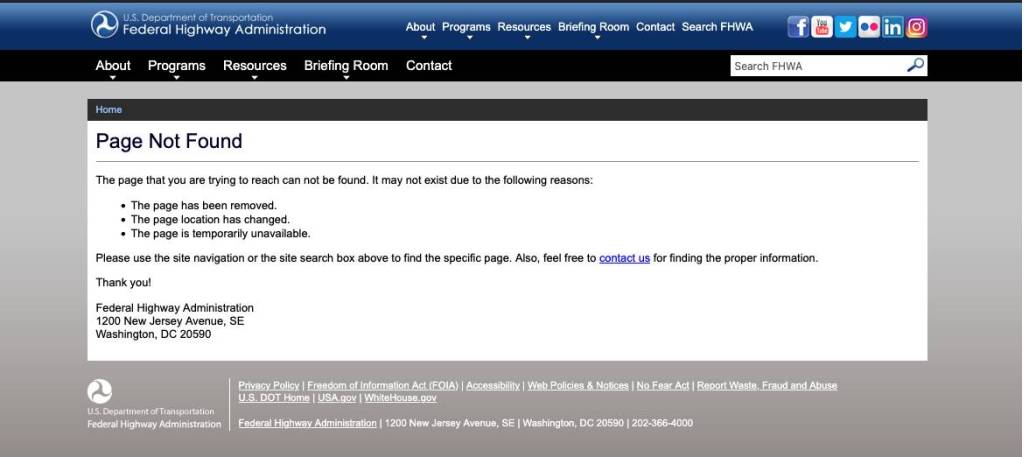
Redirect of FHWA webpage that previously contained NEVI documents from Feb. 6, 2025
The DOT stated that “effective immediately, no new obligations may occur under the NEVI Formula Program until the updated final NEVI Formula Program Guidance is issued and new state plans are submitted and approved.” Payments will still be made for projects already in progress, though.
“Until new guidance is issued, reimbursement of existing obligations will be allowed in order to not disrupt current financial commitments,” the DOT said.
Lawsuits will likely follow to free up the rest of the money, which the DOT is legally obligated to release to projects that meet requirements set out in the infrastructure law. While the DOT can issue guidance to clarify specifics, it can’t contradict the law itself or withhold funds in perpetuity.
As of late Thursday evening, the Federal Highway Administration (FHWA) had also removed NEVI documents from its website. This follows a reported pattern of information being removed from federal websites since Trump’s return to office.
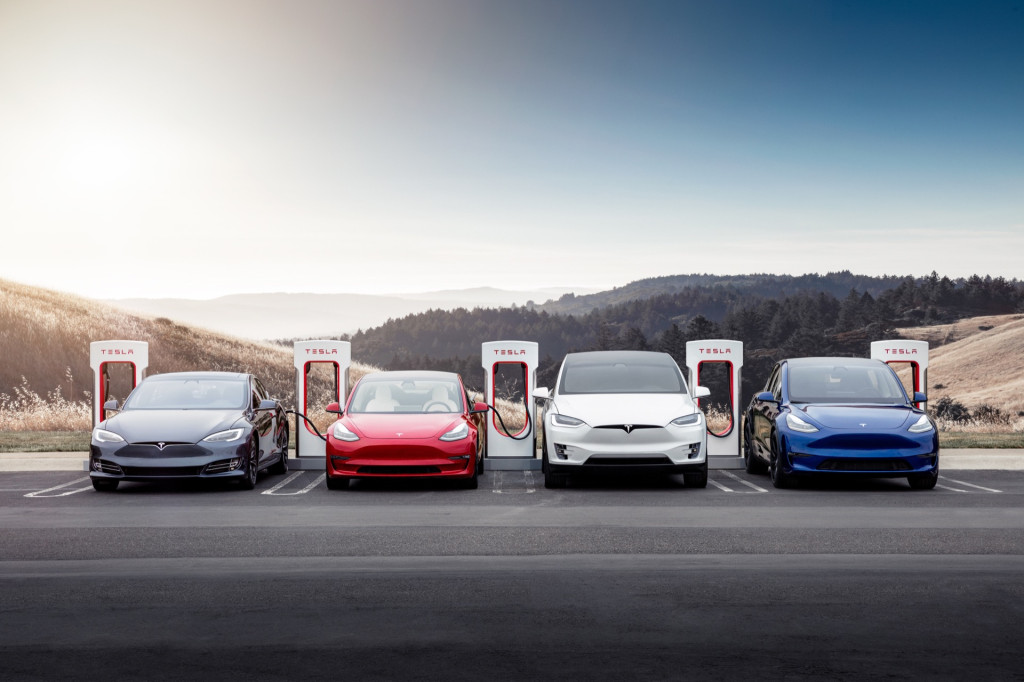
Tesla Supercharger
As Elon Musk continues to exert influence on the federal government as a private citizen, it’s worth noting that Tesla ended up winning many NEVI contracts, so this will have a serious financial affect on the EV company—and a growing conflict of interest. As of January 18, Tesla had captured more than $41 million in federal funding covering 99 different NEVI sites, according to the Paren NEVI Database.
The Ionna charging network—funded by eight full-line automakers and the most likely rival to Tesla’s Supercharger network in North America—has also suggested it will look to take advantage of the NEVI program.
Although it picked up speed last spring, NEVI-funded project rollout has been slow because states submitting plans must also deal with individual regulators, utilities, and other bureaucracies. Now that they have to submit new plans, all over again, it’s a major setback for the buildout—many months, if not years—even if the money isn’t actually taken away.

Freyr Battery cancels $2.6 billion Georgia battery factory plans
Norwegian battery firm Freyr has canceled plans for a Georgia factory that would have supplied batteries for energy storage.
First reported by the Newman Times-Herald of Newman, Georgia, Freyr confirmed plans to cancel the factory in a letter to the local Coweta County Development Authority dated Jan. 21, and in a Thursday meeting with the authority. Freyr also told the Georgia Department of Community Affairs that it would repay grants and incentives tied to the factory project.

Rendering of proposed Freyr
Announced in November 2022 and branded “Giga America,” the factory would have sat on a 368-acre site in Coweta County, which is on the southwestern edge of the Atlanta metropolitan area. Production was due to be stepped up in phases, starting with a $1.7 billion investment to build out 34 gigawatt-hours of annual production capacity. A second phase was to add more cell production lines and bring total investment to $2.6 billion by 2029.
Rising interest rates, falling battery prices, and a change in leadership at Freyr all contributed to the decision, Jason Peace, the company’s senior vice president of business development, said in an interview with The Newman-Times Herald.
Although oddly omitted in the original report, it’s hard to imagine that policies of the Trump administration pulling back on incentives for renewables wasn’t also a significant factor in this loss of potential Georgia jobs.

Rendering of proposed Freyr
Freyr is also not on totally solid financial footing, the newspaper added. In its third-quarter 2024 financial results, the company reported a net loss of $27.5 million, compared to $9.8 million for the same period in 2023. Peace told authority members that Freyr had been burning cash to get the battery plant built, and was now looking at a nearly-finished solar-panel plant in Texas as an alternative, quicker way to generate revenue.
Rivian, meanwhile, still appears to be moving ahead with plans for an EV assembly plant about an hour from downtown Atlanta. The plant was announced in 2021 and originally scheduled to open in 2024, but Rivian then paused construction. As a result, the opening was first pushed back to 2027, and then 2028, with a $6.6 billion conditional loan from the Department of Energy potentially helping get it across the line.

Karma claims these EVs and PHEVs are coming in 2025 and 2026
- Revero PHEV production continues now, limited-edition Invictus arrives in 2025
- Gyesera due in 2026 debuts new look, composite body
- Kaveya supercar due in late 2026 goes fully electric, embraces Intel architecture
- Karma’s push to power fleets and commercial vehicles has faded
It’s been more than ten years since California-based Karma Automotive initially formed with funding from the Chinese parts supplier Wanxiang Group and the assets of then-defunct Fisker Automotive.
Since then, Karma has teased a number of concept and limited-edition vehicles, along with several about-faces in business direction, all while both refining its plug-in series hybrid technology and working toward a mix of PHEVs and fully electric models in the future. Karma highlights that it engineers, designs, and manufactures its vehicles in Southern California.
Although Karma’s long-term funding situation remains unclear, it also has serious aspirations to be a technology supplier to other automakers and the industry, as evidenced by its 2024 acquisition of the tech assets and IP of over-the-air software update pioneer Airbiquity, and of its recent confirmation of a technology partnership with Intel Automotive—including co-branded inverters and more—aimed at creating and refining the architecture and software for next-gen software-defined vehicles.
“We’ve integrated that, and we continue to evolve our software platform. That’s a very, very big focus for us,” said Karma CEO Marques McCammon, of the Airbiquity acquisition. Karma’s upcoming Kaveya supercar is set to act as a “living development prototype” for the Intel architecture.
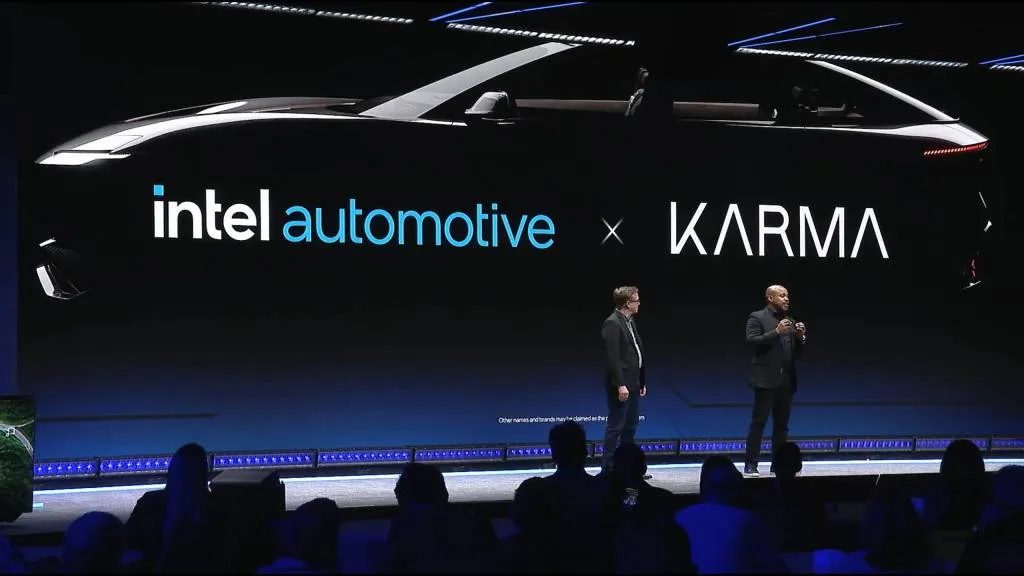
Intel Automotive and Karma
But last month, in a comprehensive interview with Green Car Reports, McCammon laid out that its primary goal remains to be a tech-forward ultra-luxury automaker with a ramped-up slate of models and an annual volume greater than what it’s managed to make cumulatively in its 10+ years.
Karma has some heavy lifting to get there. Its only current model, the Revero, returned in the fall after a production pause earlier in 2024, and McCammon confirmed that it’s once again being delivered. Deliveries in recent years have landed below a hundred vehicles a year; and earlier last year Karma said that it had delivered a cumulative 1,000 vehicles—over its entire history.
“I have no intention of claiming 50,000 or 100,000 units,” said McCammon when asked about annual volume targets. Instead, he offered, “3,000-5,000 units is where I want to be.”
“I can be at the ultra-luxury or exotic level and I can lean into the technology aggressively, and I’m small so I can move fast,” he said, summing up the philosophy. “And then I can share it.”
Sitting down with McCammon at CES, we had the CEO run through what will get him to annual production and sales of thousands rather than hundreds, and of the kind of desirability that will nurture Karma as a tech supplier.

Karma Revero GTS
Karma Revero, EREV series-hybrids remain the foundation
The Revero (also called the Karma GS-6 for a brief time) is a continuation of the Fisker Karma, which was first delivered in 2011. It carries most key aspects of the original Karma’s design forward but advances with a revamped powertrain and an updated interior. The plug-in series-hybrid propulsion system was featured in the Fisker Karma and is derived from a Quantum Technologies system originally developed for military vehicles. But Karma has extensively revamped that since the Fisker days, with a more powerful and refined 1.5-liter BMW turbo-3 and a bigger 28-kwh battery pack introduced for 2020.
In Karma’s so-called EREV system, the gasoline engine runs a generator when needed, while a dual-motor propulsion system produces 536 hp with additional electricity from the engine—delivering a 4.5-second 0-60 mph time—or 476 hp without the engine starting. The Revero was EPA-rated at 61 miles of range for the 2020 model year and specs haven’t changed significantly since then.
With it, the Revero is one of the few plug-in hybrid models on the market that can fast-charge. On an easy-to-find 50-kw CCS connector it can get to 80% in 24 minutes, according to Karma—so a quick charge during lunch might allow you more than 100 electric miles over the course of the day.
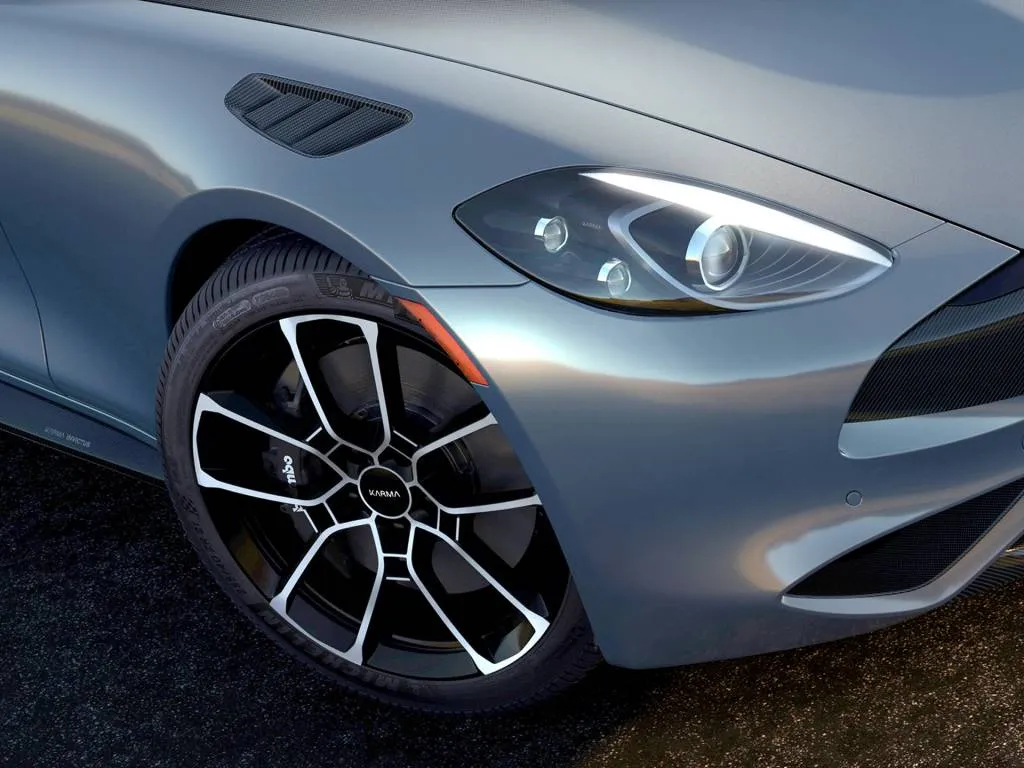
Karma Revero Invictus
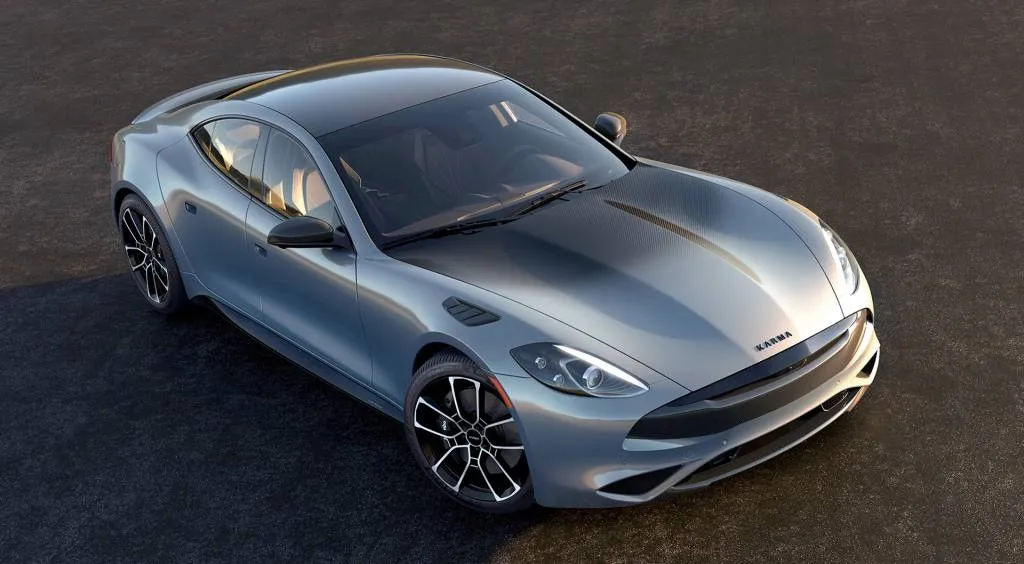
Karma Revero Invictus
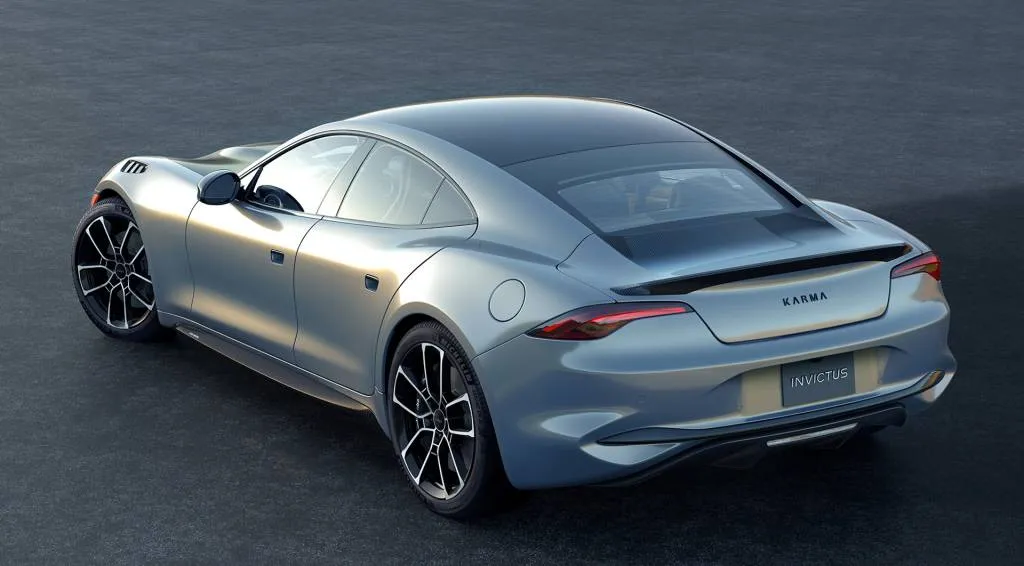
Karma Revero Invictus
Invictus transforms Revero, adds performance focus
The Karma Invictus comes next—later this year. As a special edition of the Revero, it’s set to be built around “a chassis more tightly refined for performance,” said McCammon, and it will weigh less overall than the Revero.
Karma has promised performance upfits including Öhlins dampers, Swift springs, and Michelin Pilot Sport 4S tires for the Invictus.
“We replace aluminum paddles with carbon; we lighten the vehicle up and we make it a fun driving machine; and then we do some really trick things on the interior, like hand-stitched themes where we draw from the Chrysler Building in New York,” said McCammon. “It’s very Art Deco—a collectible car.”
The Karma and Invictus will continue to take advantage of Karma’s body shop in Moreno Valley, California, which was configured to build a whole set of vehicles all starting with the same aluminum space frame.
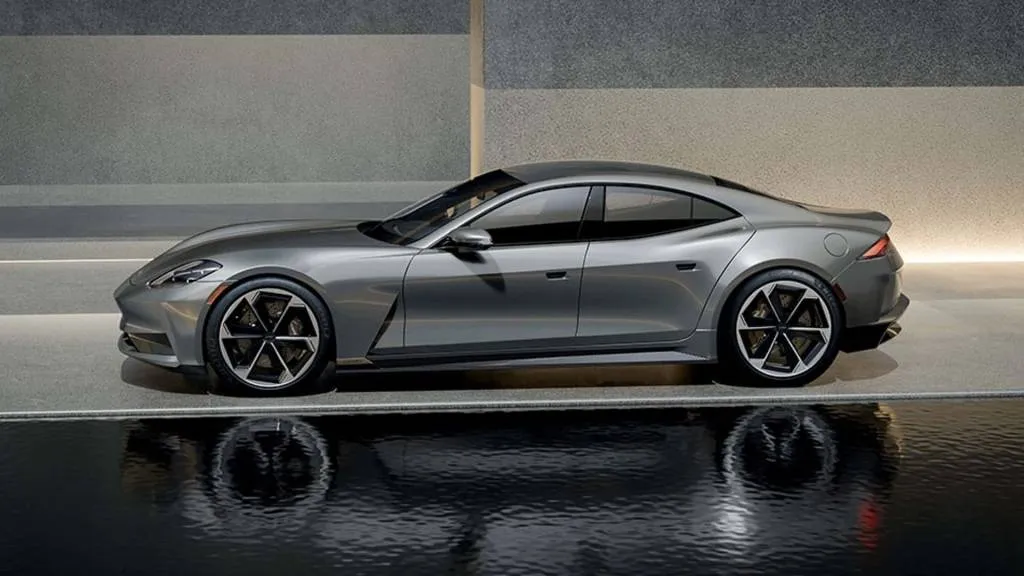
Karma Gyesera
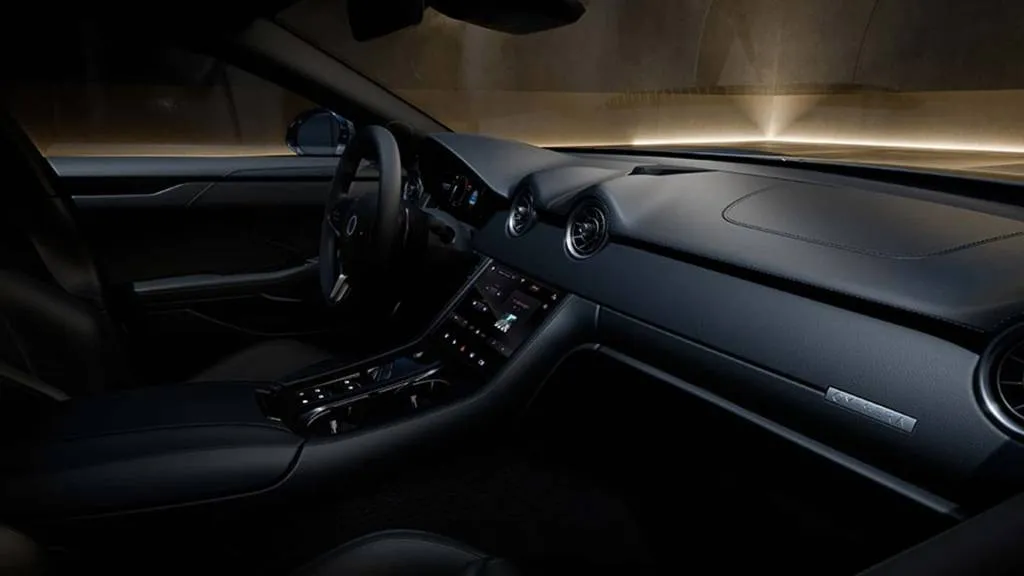
Karma Gyesera
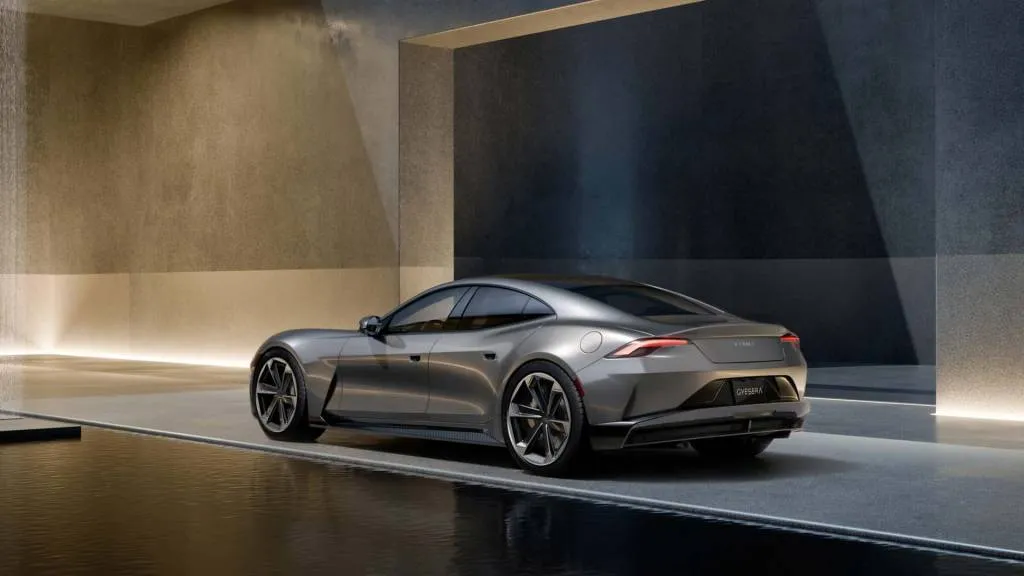
Karma Gyesera
Gyesera embraces composite body, new look
After Invictus comes the Gyesera, which McCammon described as a “new rebodied car.”
“It’s a whole new interior, whole new exterior, we’re moving away from aluminum for the body, and we’re focusing more on composite, so we have lighter weight, more high-performance, more exotic, frankly.”
Work on the composite body is being done partly in house and partly with suppliers. Its shop in California can paint composite panels but not make them. It’s specced and designed, then shipped in.
The Gyesera was originally due in 2024, and when we asked McCammon when it was arriving instead, he hinted that it’s changed direction over time. Although the Gyesera was originally supposed to be the first departure from that range extender, he suggested it will likely instead be a plug-in hybrid.
“We’ve been actively reevaluating that since June of last year, just because of the shift in market perception around EVs,” he said. “Right now with our EREV, I don’t know of anyone in the world—no one in North America—has an EV-only range of up to 80 miles.”
Sometime beyond the Gyesera, Karma has also suggested that a plug-in hybrid SUV might be in the way, maybe one like the Karma Ivara concept shown last year.
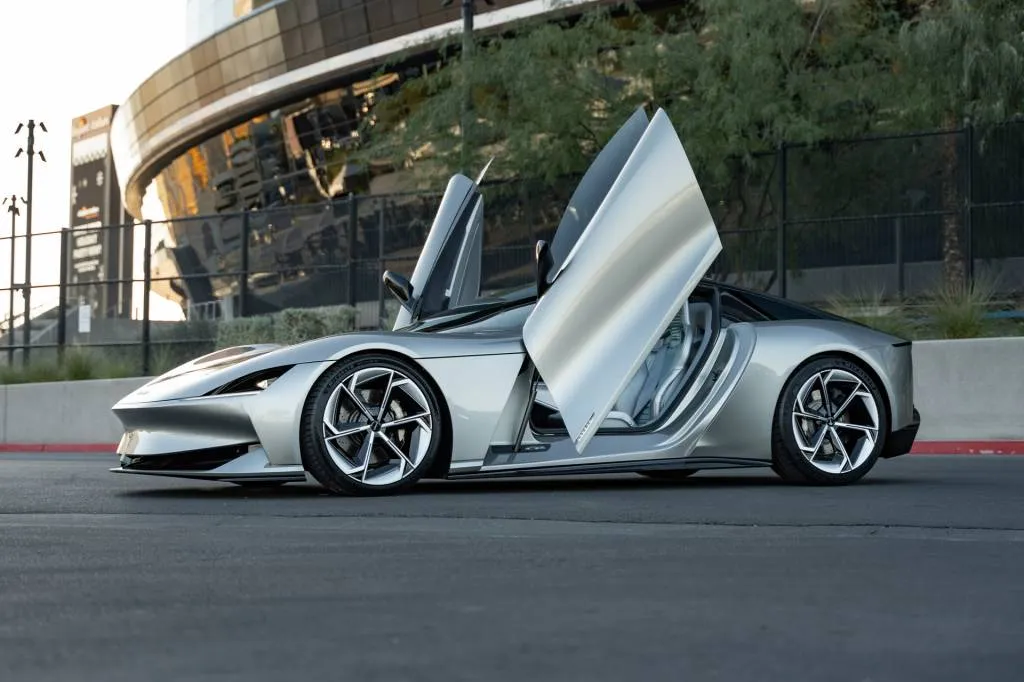
Karma Kaveya concept
1,000-hp Kaveya EV supercar tests Intel architecture
The exotic-looking, fully electric Karma Kaveya comes next, in late 2026—or perhaps sooner, hinted McCammon. It will produce 1,000 hp and be capable of accelerating to 60 mph in the vicinity of two seconds.
Although the Kaveya looks completely different, it will still build on Karma’s physical platform, meaning its aluminum space-frame layout and some of the chassis pieces. This will allow lots of commonality despite the adoption of the Intel whole-vehicle electrical architecture.
“We can change the spine, the length, the height, and don’t have to change the fundamental platform,” said McCammon. “So we can translate from a Revero or Gyesera to Kaveya and still have 40-plus-percent common content.”

Karma EREV E-Flex van concept
Commercial vehicles on the sidelines, design up front
Karma still plans to support commercial vehicles on its platform, McCammon said, but it won’t be at the core of the business as it appeared to be in 2021 when the company announced it would go after the electrified bus, RV, and box-truck market with a “Powered by Karma” banner. The focus will instead be on passenger vehicles, and specifically those at the upper end of the market—“American ultra-luxury,” as McCammon put it.
Based on the use case, its propulsion platform could have different configurations, including some built around 400 volts and others around 800 volts. That could include 800-volt versions for a super coupe or a crossover—allowing faster charging, among other advantages—plus a 400-volt version for commercial vehicles.

Karma Everyday BEV E-Flex platform
In addition to technology, design is the second key point that will get Karma to higher but still-exclusive volumes, the CEO explained. Between VP of design Michelle Christensen and Nick David as interior design director, they’re working as a team to give the vehicles a fresh look.
”I asked Michelle to take everything she has done in the studio and translate it into our entire brand experience,” McCammon explained. “Nick continues to work on the vehicle, but now she’s expanding that so every touch point of Karma has the same aesthetic.”
While Karma isn’t wound up in a typical startup hype cycle, it’s still trying to prove itself with finite resources. What it might deliver in tech and design all its own is still taking form—but it’s due very soon.

2025 Jeep Wagoneer S Limited expand EV lineup for $66,995
The 2025 Jeep Wagoneer S electric SUV makes the transition to regular production after a truncated first model year.
Unveiled Thursday at the 2025 Chicago auto show, the 2025 Jeep Wagoneer S Limited grade joins the Launch Edition version that kicked off sales of Jeep’s first EV for North America late last year as a 2024 model. It’s priced at $66,995 (including a $1,795 destination charge)—$5,000 less than the Launch Edition that’s arrived for a brief 2024 model year.
The Limited will get the Launch Edition’s 600 hp and 617 lb-ft of torque, but only through an extra-cost over-the-air (OTA) update as part of an Propulsion Boost Package arriving later in the model year. Otherwise, true to the badging, it’s limited to 500 hp and 520 lb-ft.
That higher of the outputs helps make the Wagoneer S the quickest Jeep in history. In a first drive of the Launch Edition model, we found that it also strays from Jeep brand identity. A production version of the off-road-ready Wagoneer S Trailhawk concept shown last year would address that, but so far there’s no hint from Jeep that it’s on the way.

2024 Jeep Wagoneer S test drive review
The Wagoneer S Limited doesn’t have EPA range ratings yet, but it does have the same 100-kwh battery pack that can be charged from 20%-80% in 23 minutes and is rated at 303 miles in the Launch Edition. All Wagoneer S models include an offer of a 48-amp Level 2 AC home charger or credits of equivalent value for use at public charging stations.
The Limited carries forward some design elements from the Launch Edition, including a lack of chrome trim and standard 20-inch wheels. But those wheels have a machined aluminum finish instead of gloss black, and they’re accompanied by a black roof and mirror caps.

2025 Jeep Wagoneer S Limited

2025 Jeep Wagoneer S Limited
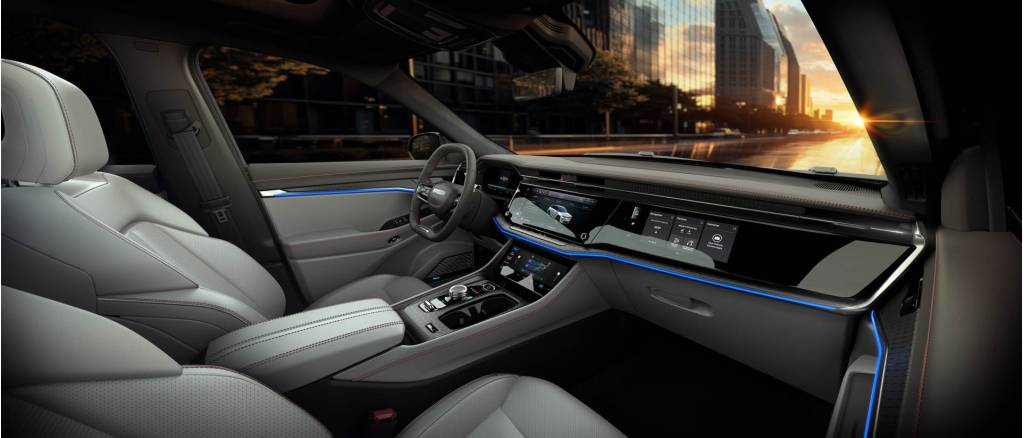
2025 Jeep Wagoneer S Limited

2025 Jeep Wagoneer S Limited
Inside, the Wagoneer S Limited can be equipped with the same three-screen arrangement as the Launch Edition, encompassing a 12.3-inch central display, 12.3-inch instrument cluster, and 10.2-inch front-passenger display. A dual-pane panoramic sunroof and 10-way power-adjustable heated front seats are standard as well, while a McIntosh high-end audio system is optional.

VW confirms multiple sub-$25,000 EVs, teases likely ID.1
- Entry-level EV teased; likely ID.1 will start under $21,000 in Europe
- Nine new models by 2027, including ID.2all, electric Golf, electric T-Roc crossover
- Volkswagen hasn’t confirmed if any of those EVs are U.S.-bound
The big future that Volkswagen sees for its core brand brings it back to its roots: affordable small cars—at least for Europe.
On Wednesday, VW confirmed plans for an entry-level, fully electric small car starting at less than $21,000 (around 20,000 euros), due in 2027. While it gave employees a first look at the model, VW announced that it will be showing this entry EV to the public at the beginning of March.
The small EV, widely expected to be called ID.1, was pitched by Volkswagen Passenger Cars CEO Thomas Schäfer as “an affordable, high-quality, and profitable electric Volkswagen from Europe for Europe.”
The likely ID.1, which even from the teaser photo above appears to channel some heritage from the successful Up—and fully electric e-Up—city car, will fit in its EV lineup next to the production version of the VW ID.2all, which comprises a small-car family that represents the evolution of VW’s MEB foundation for affordable EVs and is set for a 2026 introduction with a starting price under $26,000 (25,000 euros).

Volkswagen ID.2all concept

Volkswagen ID.2all concept

Volkswagen ID.2all concept
In all, VW plans nine new models by 2027, including the ID.2all and entry-level EV. so it’s unclear whether this model might see other markets like North America as also within its lens. Green Car Reports has reached out to Volkswagen of America for some context—and especially whether the recent cancellation of the ID.7 is any indication U.S. EV products will go in the same affordable direction.
VW didn’t confirm where these new European models would be built—Spain is the likely location, based on reports—but it did say it would keep its home Wolfsburg plant the core of VW as it shifts to EVs. That means shifting Golf production to Mexico to make room at Wolfsburg for a next-generation electric Golf and upcoming electric T-Roc crossover.
In 2019 VW envisioned a much higher volume for its EVs, targeting 15 million EVs across 50 EV models globally by 2028 with a strong focus on Europe, North America, and China, plus a second wave of models providing even more growth.
VW said Wednesday that globally it has sold more than 1.35 million ID vehicles since it introduced the product family in 2019, and last year it reached 383,100 EV sales.
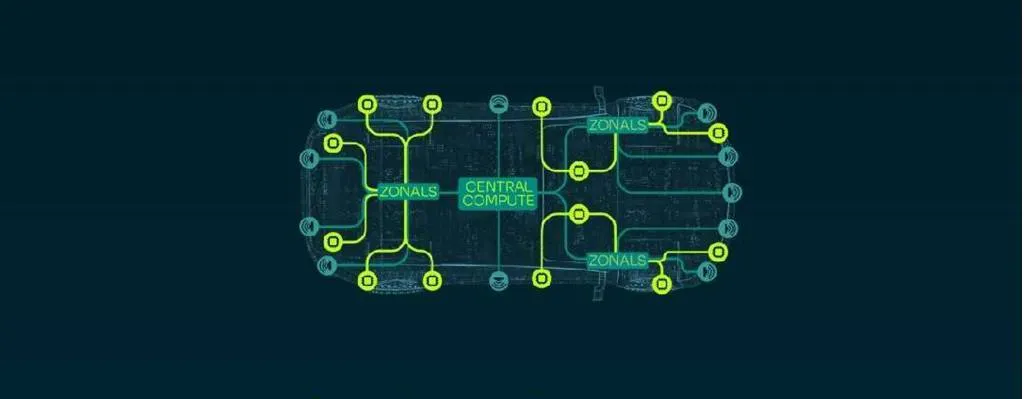
Rivian and Volkswagen Group electrical architecture and software stack
As of yet VW’s progress has been hindered by an array of issues, ranging from supply chain and software issues to a Chinese market landscape that’s evolved to favor local EV makers. But a recent $5.8 billion investment and joint venture with Rivian extending to electrical architecture and software may help ease the way in future mass-market EVs, including small cars.

Planned merger between Honda and Nissan may be in trouble

- Nissan and Honda are “advancing various discussions” regarding proposed merger
- Honda reportedly proposed to make Nissan a subsidiary
- Merger is seen as potential lifeline for Nissan, would create one of world’s largest automakers
The anticipated merger between Honda and Nissan announced last December, may be encountering significant challenges that, according to reports, could potentially lead to its cancellation.
Initially, both automakers planned to finalize their decision by the end of January, but the deadline has been pushed back to mid-February. New tariff threats by the Trump administration are also likely to be weighing on the deliberations.
Now a series of reports citing insiders—and potentially part of the give-and-take of negotiation—indicate that Nissan is reconsidering its participation in the merger.
Citing several sources, Reuters reported on Wednesday that Nissan’s management expressed concerns over Honda’s proposal to make Nissan a subsidiary, a move that could diminish Nissan’s decision-making authority within the partnership. That report also appears to imply that negotiations have halted or that Nissan has withdrawn while it retains the option to restart negotiations.
Nissan, after that report, has issued a statement confirming that discussions have not ended. “Based on the memorandum of understanding signed on December 23 last year, Honda and our company are in the stage of advancing various discussions, including the contents of the report, and we plan to establish a direction and make an announcement around mid-February,”
Honda had not yet at the time of writing issued its own equivalent statement. Japan’s Asahi Shimbun also reported on Wednesday, perhaps as part of these “discussions,” that Honda executives are frustrated with Nissan’s slow progress in both the merger discussions and the implementation of a restructuring plan. This plan includes the reduction of 9,000 jobs and a 20% decrease in production capacity.
Unlike Honda, Nissan has been struggling with declining sales, particularly in the U.S. and China, raising uncertainty about its future without the merger. Without a clear path forward, the merger has been seen as a potential lifeline. The Financial Times in its own report on Wednesday highlighted that Nissan’s recent poor financial performance has caused its market capitalization to shrink to just one-fifth of Honda’s, altering the balance of power in the negotiations.
Mitsubishi, which is already partially owned by Nissan, was invited to join the merger. However, reports from January suggested that Mitsubishi preferred to stay out of the merger, citing its smaller size and concerns over losing independence within the combined entity.
Even without the merger, Honda and Nissan may deepen their collaboration. The automakers are already partnered in some areas. Honda and Nissan have been collaborating on EV and software development since early last year, and Mitsubishi joined the partnership last summer. Nissan and Mitsubishi also already share vehicle platforms and technology via their existing alliance, which also includes Renault. Mitsubishi has also collaborated with Honda in the past, most recently in battery leasing for EVs through a joint venture called Altna.
Combined sales of Honda and Nissan in 2023 totaled more than 8 million vehicles. That would make the merged automaker, estimated to have a value of around $58 billion, the third largest by sales volume after Toyota and the Volkswagen Group, which sold 11.2 million and 9.2 million vehicles in 2023, respectively.

Ionna scales up toward targeted 30,000 EV chargers by 2030

The U.S. EV charging network Ionna is picking up speed in its infrastructure build-out as the nascent network aims to make good on its promise of installing tens of thousands of electric vehicle chargers over the next five years.
It said on Tuesday in a press release that it is transitioning “from public beta to full-scale national release” following the opening of its first location and the conclusion of a testing program in 2024.
The testing program involved more than 4,400 charging sessions with more than 80 unique EV models, dispensing nearly 63,000 kwh of energy, according to Ionna. It added that the goal was to “stress-test” the network; now the focus shifts to the network build-out.
Ionna was initially backed by seven automakers, including BMW Group, General Motors, Honda, Hyundai, Kia, Mercedes-Benz, and Stellantis. Toyota joined Ionna in 2024. The network was announced in 2023 as the first potential rival to the Tesla Supercharger network in North America, and has steadily built momentum as plans for continued expansion of the Supercharger network have fluctuated.
Ionna now claims to have more than 100 contracted charging sites nationwide, and just this week announced new sites in Houston, Texas; Abilene, Kansas; and Wilcox, Arizona. Those join six already under construction. They’ll be accompanied by new tech features, including expanded Plug & Charge compatibility and Amazon “Just Walk Out” tech that lets drivers grab refreshments without having to wait in line.
Its first location is in Apex, N.C., in what Ionna refers to as a “Rechargery”—in a converted gas station.
Ionna hopes to have 1,000 new charging bays online by the end of the year, on the way to a goal of 30,000 bays by 2030 that was first announced in 2023. “Bays” is the metric Ionna uses in place of charging connectors. It essentially means charging spots, although each spot can have multiple connectors. Those connectors can be CCS or NACS, it has noted.

Mercedes-Benz EVs can now charge on Tesla Superchargers
As promised, Mercedes-Benz electric vehicles can now charge at 20,000 Tesla Supercharger stations in the U.S. market.
Mercedes-Benz said in January access to Tesla’s Supercharger charging network would open to the German EVs in February. While Mercedes didn’t announce the switch has been flipped, Tesla updated its list of automakers with access to the Supercharger network shifting Mercedes-Benz from “coming soon” to “supported.”
Supercharger will be enabled via a software update installed by dealerships—not over-the-air. Customers will be contacted by Mercedes to schedule this. The update will preserve the plug-and-charge capability offered in current Mercedes EVs, allowing drivers to charge simply by plugging in, and allow Superchargers to show up on the Mercedes app and infotainment systems.

Mercedes-Benz opens Tesla Supercharger access
Adapters cost $185 and will also be distributed through dealerships. They’ll be available in the U.S. this quarter, Mercedes said, but Canadian drivers will have to wait until Q2. Pricing for that market will be confirmed at a later date. Between the U.S. and Canada, Mercedes expects drivers to have access to about 20,000 Supercharger stations.
Mercedes plans to build Tesla NACS ports into new vehicles for North American markets starting this year. So far the refreshed 2025 Hyundai Ioniq 5 is the only non-Tesla EV on sale with a NACS port—and it charges slower with it. That’s because most Tesla Superchargers can’t currently charge at 800-volt peak rates, which doesn’t apply to 400-volt Mercedes EVs on the road today.
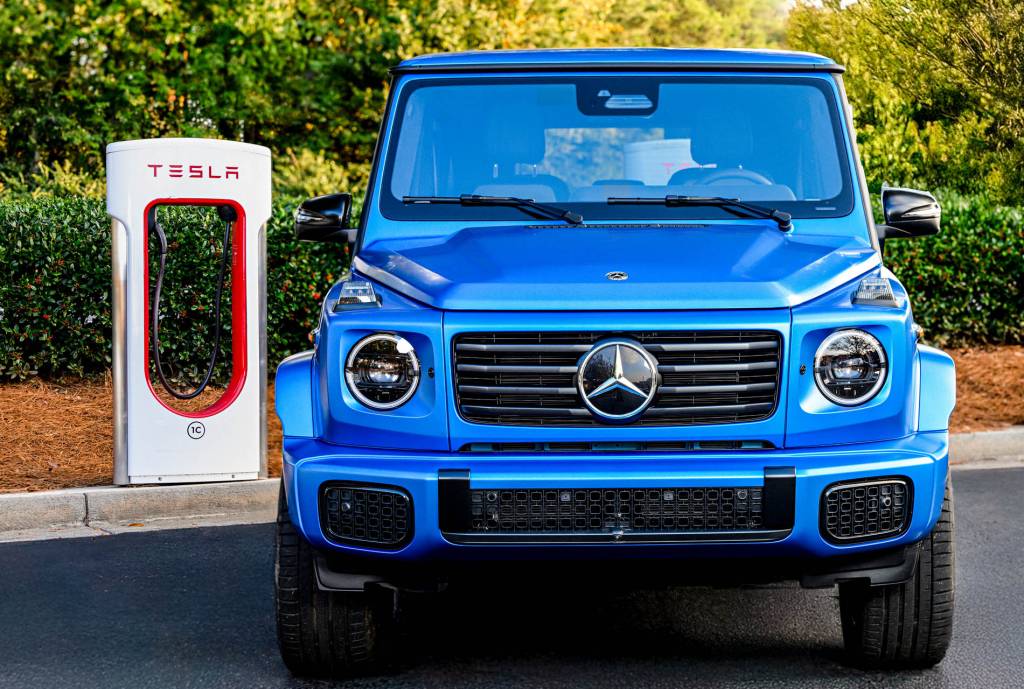
Mercedes-Benz opens Tesla Supercharger access
Mercedes joined the list of brands switching to NACS in July 2023, even as it was working on its own fast-charging network. The first location, featuring 400-kw DC fast chargers provided by ChargePoint, opened in Georgia in November 2023.
And it’s part of the Ionna charging network joint venture, along with seven other automakers. Ionna aims for 30,000 chargers across North America, with the first site scheduled to open later this year.
